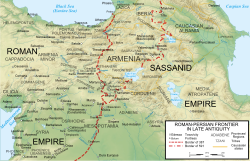Anastasian War
| Anastasian War | |||||||
|---|---|---|---|---|---|---|---|
| Part of the Roman-Persian Wars | |||||||
 The Roman-Persian frontier had remained stable since 384, when the two powers divided Armenia, and despite recurrent warfare, would not change significantly until the Lazic War. | |||||||
| |||||||
| Belligerents | |||||||
|
Byzantine Empire Arab allies |
Lakhmids | ||||||
| Commanders and leaders | |||||||
|
| ||||||
The Anastasian War was fought from 502 to 506 between the
Prelude
Several factors underlay the termination of the longest period of peace the
War

Kavad's campaign of 502
In 502, Kavad quickly captured the unprepared city of
Anastasius' campaign of 503 and Kavad's counterattack
The Byzantine emperor
Initially, Areobindus gained the upper hand in Nisibis, but Kavad's counterattack defeated him, plundered his fort Apadna, and forced him to retreat westward; Hypatius and Patricius attempted to assist him, but it was too late.
Anastasius' renewed assault
In the summer of 503, Anastasius sent reinforcements under
Peace treaty
In the same year, an armistice was agreed as a result of an invasion of Armenia by the
Aftermath
The Roman generals blamed many of their difficulties in this war on their lack of a major base in the immediate vicinity of the frontier, a role filled for the Persians by Nisibis (which until its secession in 363 had served the same purpose for the Romans), and in 505 Anastasius therefore ordered the building of a great fortified city at Dara. The dilapidated fortifications were also upgraded at Edessa, Batnae and Amida.[16]
Although no further large-scale conflict took place during Anastasius's reign, tensions continued, especially while work continued at Dara. This construction project was to become a key component of the Roman defenses, and also a lasting source of controversy with the Persians, who complained that its construction violated the treaty agreed in 422, by which both empires had agreed not to establish new fortifications in the frontier zone. Anastasius, however, pursued the project, deflecting Kavad's complaints with money.[17] The Persians were in any case unable to stop the work, and the walls were completed by 507/508.[13]
References
- ^ The sources are contradictory about the role played by Constantine during the siege of Theodosiopolis. According to Zacharias Rhetor, (Greatrex & Lieu 2002, p. 63) he was taken prisoner, while according to Joshua the Stylite, due a grudge he bore against the emperor Anastasius, he betrayed the Romans. (Joshua the Stylite, Chronicle 48)
- ^ Procopius. History of the Wars, I.7.1-2; Greatrex & Lieu 2002, p. 62.
- ^ Greatrex & Lieu 2002, p. 62.
- ^ Greatrex & Lieu 2002, p. 63.
- ^ A. Shapur Shahbazi, Erich Kettenhofen, John R. Perry, “DEPORTATIONS,” Encyclopædia Iranica, VII/3, pp. 297-312, available online at http://www.iranicaonline.org/articles/deportations (accessed on 30 December 2012).
- ISBN 978-90-04-25446-6.
- ^ ISBN 978-0-19-936274-5.
- ISBN 978-0-88402-214-5.
- ^ ISBN 978-1-60206-445-4.
- ISBN 978-0-486-20398-0.
- ^ ISBN 978-0-415-46530-4.
- ^ Greatrex & Lieu 2002, pp. 69–71.
- ^ a b c Greatrex & Lieu 2002, p. 77.
- ^ Procopius. History of the Wars, I.9.24; Greatrex & Lieu 2002, p. 77.
- OCLC 1007044617.
- ^ Greatrex & Lieu 2002, p. 74.
- OCLC 294885267.
Sources
Primary
- Procopius; Dewing, H. B. (trans.) (1914). History of the Wars. Books I–II.
Secondary
- Greatrex, Geoffrey; Lieu, Samuel N. C. (2002). The Roman Eastern Frontier and the Persian Wars (Part II, 363–630 AD). New York, New York and London, United Kingdom: Routledge (Taylor & Francis). ISBN 0-415-14687-9.
